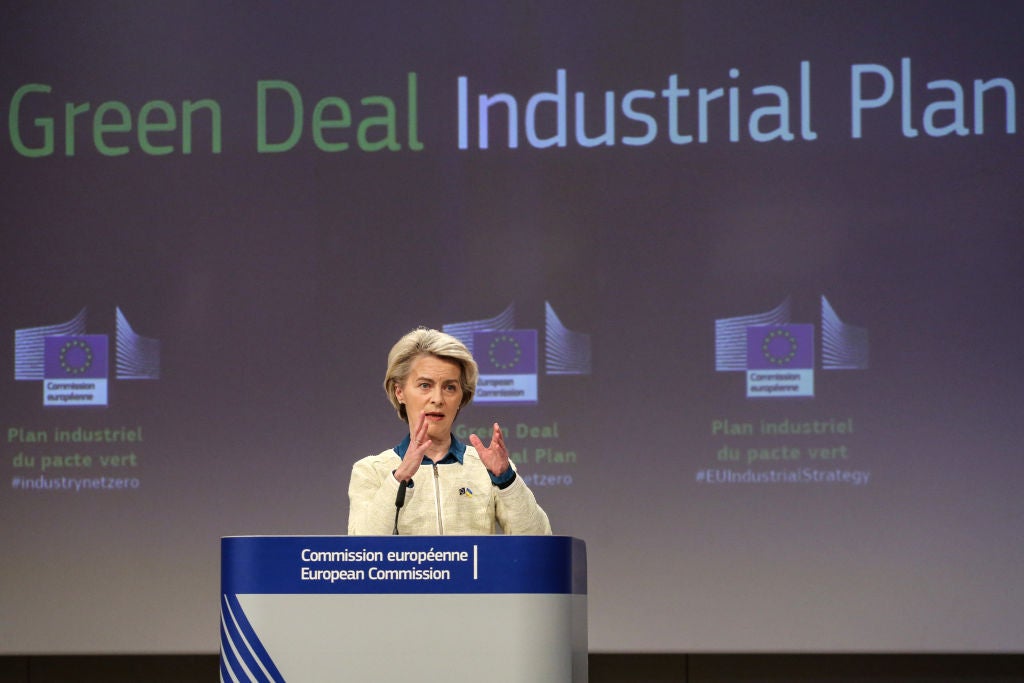On climate action and the energy transition, the EU is sailing an ambitious course in stormy waters. In recent weeks, the European Commission has proposed a Green Deal Industrial Plan and measures to cut emissions from heavy-duty vehicles, while the rest of the EU machinery rolls forward with laws on sustainable finance, greenwashing and energy-leaky buildings. Among all the good stuff, however, lurk some ill winds.
Russia’s invasion of Ukraine, a year ago today, and decision to massively reduce exports of piped gas to Europe has increased coal use in some countries this winter and the EU has spent huge amounts of money procuring liquified natural gas from other suppliers. However, Moscow’s aggression has also pushed the EU to go further and faster in its transformation to a clean energy economy. The war may have “fast-tracked the [energy] transition [in Europe] by an astonishing five to ten years,” concluded the Economist earlier this month.
If a speedier reduction in emissions, greater EU energy security and a new era of green industry in Europe are to be the positive legacies of the dire situation in Ukraine, the EU must hold its nerve and be clear about its intentions.

The Green Deal Industrial Plan was welcomed by industries old and new, but there was concern the proposal read more like a roll call of sectors than a proper plan.
“It is critical when European leaders meet again in March, they clearly set out the strategic sectors that can expect support,” said Walburga Hemetsberger, CEO at industry organisation SolarPower Europe, when the plan was announced. To achieve both its energy security and climate goals, the EU should focus on supporting “true technologies” that have the greatest potential. “That means solar PV, wind turbines, heat pumps, batteries and EVs,” Hemetsberger said, pointedly excluding carbon capture and storage.
The Commission says its starting point is “technology neutrality” and the precise scope of technologies that could benefit from looser state aid laws “remains to be defined”. The EU executive’s stance is likely to become clearer in its Net-Zero Industry Act on 14 March. That proposal risks a huge backlash from cleantech industries and environmental campaigners if it includes any possibility of support for fuel fossil industries.
Yet despite strong words on net zero, the EU appears unable to let go of the gas crutch. The most obvious example is the Commission’s continued defence of its decision to include gas in the EU taxonomy aimed at showing which investments are sustainable – but this is not a one-off. Across legislative proposals, the least-polluting fossil fuel continues to be defended as a necessary part of the transition, even though cleaner options are often ready to take its place.
At the beginning of February, the European Parliament’s industry committee voted on the Energy Performance of Buildings Directive, whose purpose is to trigger a “renovation wave” and a move from fossil fuel boilers to lower-emitting electric heat pumps. The committee failed, however, to set a definitive end-date for fossil fuel boiler sales, leaving the door open to hybrid boilers, which run on gas but can be switched to hydrogen or biomethane, to be considered ‘green’.
In practice, given that biomethane will only ever cover a small part of the market and there are considerable doubts as to whether hydrogen will ever run through household pipes, campaigners are concerned that natural gas will remain in heating systems much longer than policymakers suggest.
[Keep up with Energy Monitor: Subscribe to our weekly newsletter]
“We don’t want a situation as happened with solar panels, where we invented them and the production went to China,” said Frans Timmermans, Commission Vice-President for the Green Deal, in mid-February. “We want the production to be in Europe.” Timmermans was speaking about electric trucks and buses, but he could have been discussing any other clean technology that will be needed for the transition to net zero.
If Europe wants to be a hive of green industries, the EU institutions need to base their policies and support on facts, not fear-mongering from fossil fuel lobbyists or incumbent industries. In 2022, gas consumption in Europe fell, while industrial production rose, heat pump deployment shot up and, on average, in regions most affected by the energy crisis, higher shares of renewables correlated with lower electricity prices.
Climate action and the clean energy revolution can mean industry and jobs, but investors and companies need clarity about the direction of travel.




